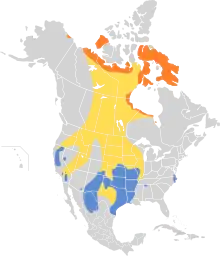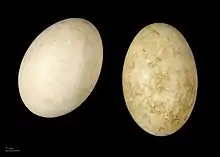Ross's goose
Ross's goose (Anser rossii) is a white goose with black wingtips and a relatively short neck. It is the smallest of the three white geese that breed in North America. It is similar in appearance to a white-phase snow goose, but about 40% smaller. Other differences from the snow goose are that the bill is smaller in proportion to its body and lacks "black lips". The dark phase is extremely rare.
| Ross's goose | |
|---|---|
_(23321411711).jpg.webp) | |
| Adult Ross's goose in Ohio, USA | |
| Scientific classification | |
| Domain: | Eukaryota |
| Kingdom: | Animalia |
| Phylum: | Chordata |
| Clade: | Dinosauria |
| Class: | Aves |
| Order: | Anseriformes |
| Family: | Anatidae |
| Genus: | Anser |
| Species: | A. rossii |
| Binomial name | |
| Anser rossii Cassin, 1861 | |
 | |
| Ross's goose range: Breeding Wintering Migration | |
| Synonyms | |
| |
Before the early 1900s, this goose was considered a rare species, possibly as a consequence of open hunting, but numbers have increased dramatically as a result of conservation measures.[2] It is now listed as a species of Least Concern by the IUCN,[3] and is protected by the Migratory Bird Treaty Act.
Ross's goose is named in honor of Bernard R. Ross (1827–1874), who was associated with the Hudson's Bay Company in Canada's Northwest Territories. Members of the Hudson's Bay Company were the first Europeans to discover the arctic nesting grounds of Ross's geese in 1940.[2] The first recognizable description of Ross's geese, under the name "horned wavey", was given by explorer Samuel Hearne eighty years before John Cassin named it after Ross.[4]
Description
Ross's goose have a rounded head above a short neck. The bill is short and triangular, and has a bluish base with warty structures that increase in prominence with age. Adults are identified by all-white secondary feathers, while juveniles' will be dark centered. Females average 6% smaller than males.[2] Legs will begin as olive gray on goslings and turn deep red as they mature.
There is no geographic variation or identified subspecies. Related species include other Anser geese, particularly the lesser snow goose,[2] where the two mtDNA lineages imply frequent hybridization.[5] Two hypotheses about the evolution of Ross's goose are that they arose from a population of snow geese that were isolated by glacial advance[6] or in a refugium that remained ice free.[7]
Measurements:
- Male
- Length: 23.2-25.2 in (59–64 cm)
- Weight: 42.3-55.3 oz (1198-1567 g)
- Wingspan: 44.5-45.7 in (113–116 cm)
- Female
- Length: 22.6-24.4 in (57.3–62 cm)
- Weight: 37.6-51.3 oz (1066-1454 g)
Habitat
Landscape in the central Arctic is dominated by flat plains with some rock outcrops and drumlins, wet meadows, and marshy tundra. Vegetation includes patches of dwarf birch, willow, grasses, sedges,[8] and low-growing vascular plants including crowberry, lapland rosebay, and lousewort.[2] Large colonies of nesting birds can cause extensive damage to plants by overgrazing.[9]

Behavior
Ross's geese form large nesting colonies on islands in shallow lakes and adjacent mainland, building nests on the ground made of twigs, leaves, grass, moss, and down.[10] Females lay an average of 4 eggs per clutch and incubate the nest for 21–23 days.[10]
A study of ground-based sampling along the McConnell River on the west coast of Hudson Bay reported a population of about 81,000 nesting Ross's geese.[11]
These birds migrate from their Canadian nesting grounds by mid-October, probably in response to limited food before freezing temperatures set in, and begin their return in mid-April to May.[12]
Like most geese, they are grazers that feed on grasses, sedges, and small grains. They often forage in large mixed flocks with snow geese.

Conservation and management
The number of nesting birds in the Queen Maud Gulf hit a record low of 2,000-3,000 in the early 1950s[13] due to extensive shooting and trapping and their subsequent sale in California markets.[14] Hunting of Ross's geese was made illegal in the U.S. in 1931. When populations on wintering grounds began to increase again, restricted hunting was introduced.[15] Today, Ross's goose is protected under the Migratory Bird Treaty Act.
References
- BirdLife International (2016). "Anser rossii". IUCN Red List of Threatened Species. 2016: e.T22679909A92834499. doi:10.2305/IUCN.UK.2016-3.RLTS.T22679909A92834499.en. Retrieved 12 November 2021.
- Jónsson, J.E.; Ryder, J.P.; Alisauskas, R.T. (2013). Ross's Goose (Anser rossii). Ithaca, NY, USA: Cornell Lab of Ornithology.
- BirdLife International (2016). "Anser rossii". IUCN Red List of Threatened Species. 2016.
- "Once Upon a Time in American Ornithology". The Wilson Journal of Ornithology. 118 (4): 577–579. 2006. JSTOR 20455932.
- Weckstein, Jason D.; Afton, Alan D.; Zink, Robert M.; Alisauskas, Ray T. (2002). "Hybridization and population subdivision within and between Ross's Geese and Lesser Snow Geese: A molecular perspective". The Condor. 104 (2): 432–436. doi:10.1650/0010-5422(2002)104[0432:hapswa]2.0.co;2.
- Johansen, H (1956). "Revision and origin of the arctic bird fauna". Acta Arctica. 8: 1–98.
- Ploeger, P. L. (1968). Geographical differentiation in Artic Anatidae as a result of isolation during the last glacial. EJ Brill.
- Ryder, John P. (1967). The breeding biology of Ross' goose in the Perry River region, Northwest Territories (PDF). Queen's Printer. OCLC 463254.
- Kotanen, Peter M.; Jefferies, Robert L. (1997). "Long-term destruction of sub-arctic wetland vegetation by lesser snow geese" (PDF). Écoscience. 4 (2): 179–182. doi:10.1080/11956860.1997.11682393. hdl:1807/73663.
- "Ross's Goose". Audubon. 2014-11-13. Retrieved 2019-04-08.
- Alisauskas, Ray T.; Drake, Kiel L.; Caswell, Jason H.; Kellett, Dana K. (2012). "Movement and persistence by Ross's Geese (Chen rossii) in Canada's arctic". Journal of Ornithology. 152 (2): 573–584. doi:10.1007/s10336-010-0635-4. S2CID 14607362.
- Dzubin, A (1965). "A study of migrating Ross' Geese in western Saskatchewan". The Condor. 67 (6): 511–534. doi:10.2307/1365615. JSTOR 1365615.
- Kerbes, Richard (1994). Colonies and numbers of Ross' Geese and Lesser Snow Geese in the Queen Maud Gulf Migratory Bird Sanctuary (PDF). Saskatchewan, Canada: Canada Wildlife Service.
- Grinnell, Joseph; Miller, Alden (1944). The Distribution of the Birds of California. Berkeley, California: Cooper Ornithological Club.
- McLandress, M. R. (1979). "Status of Ross' Geese in California". In Jarvis, R. L.; Bartonek, J. C. (eds.). Management and biology of Pacific flyway geese. Corvallis, OR: OSU Book Stores. pp. 255–265.
External links
- Ross's Goose - Chen rossii - USGS Patuxent Bird Identification Infocenter
- Ross's Goose Species Account - Cornell Lab of Ornithology
- "Ross's Goose media". Internet Bird Collection.
- Ross's Goose photo gallery at VIREO (Drexel University)
